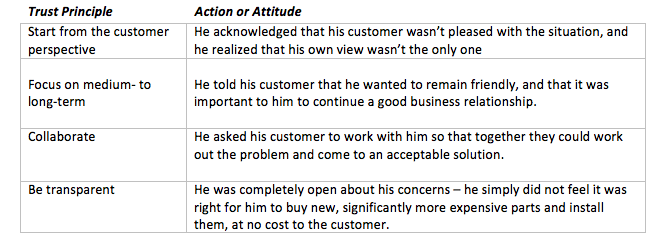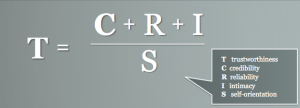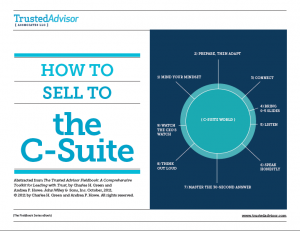25 Warning Signs You Have a Low-Trust Organization: Part 1 of 5
Low-trust organizations are petri dishes for low growth, profitability, and ultimately survival. Yet the signals are easy to ignore.
The canaries in the low-trust coal mine fall into five groups: we’ll devote one blog post to each of:
- Employees (today’s post)
- Teams
- Leadership
- Products and Services
- Clients and Customers
Employee Warning Signs of a Low-Trust Organization
Look around your offices. Do you see the following five signs? Then you might be a member of a low-trust organization.
1. The copy room bulletin board has those round smiley cartoon figures laughing and rolling on the floor saying, “You want it WHEN?!”
- Humor is revealing. This particular cartoon pokes fun at the internal customer. Allegedly. When is it a good idea to make jokes about the customer?
- What it really indicates is insecurity on the part of the copy room staff. What it really says is, “Please don’t blame me, I feel un-validated around here. And besides, all I want is to follow simple rules that I don’t have to think about, why are you making my life so miserable with all your requests?”
- And when you see those cartoons, it isn’t just about the copy room. They’re a canary in the company mine. It means you’ve got insecure employees reporting to people who can’t give clear feedback, and a culture of entitlement. Good luck trying to get things done around that place.
2. People email others on the same floor way more than they talk to each other.
- Sure, email provides an invaluable record of communication. And yes, it’s efficient. And no, I’m not going to say you have to be more empathetic and caring in all your relationships – that’s your call.
- But email is for transactions. An organization that kids itself that it can reduce all decisions to transactions is an organization that can’t tell forests from trees.
- Interactions that are overweighted into transactions become poor at executing strategies (despite their attention to detail), because strategies require frequent strategic-level thinking.
- A culture that over-celebrates impersonal transactions is likely to be non-innovative, because innovation thrives on the trust that allows people to challenge each others’ ideas.
3. Blame stalks the halls.
- One of the worst sayings is, “No one ever got fired for hiring [IBM, McKinsey, etc].” It may not be bad for IBM or McKinsey, but it means that business decisions are being made by employees based on personal risk-aversion, rather than on the organizational good. That makes for some very bad decisions.
- Behind blame lies fear. Employees driven by fear will never properly value risk. They will avoid people and decisions based on their personal fears; this avoidance increases inefficiencies and lowers innovation. Ironically, it ultimately also raises risk.
- Blame is captivity, as Phil McGee says. When blame reigns, you can’t tell who’s responsible. When you’ve got no responsibility, accountability is meaningless. Blame leads to ineffectiveness; and that means you can’t make decisions, respond to markets, or do positive things.
4. People talk about each other.
- People talking frequently about each other suggests gossip, which usually means talking behind people’s backs. This signals an inability to confront real issues. This means politics replaces truth telling.
- Ask someone where they work in an organization. At a great company, it might be “in bubble memory technology.” Or, “in the semiconductor division, in R&D.” In a low-trust organization, the answer will be, “In Robinson’s group.”
- The cult of leadership is just another cult. Steve Jobs may have been revered (or not), but he knew the desired obsession was not about personality, but the business. Celebrate, but don’t idolize.
5. People complain.
- Complaining is wrong because it is wishing, not doing. If you didn’t win the lottery, you’ve no business complaining if you didn’t buy a ticket.
- And if you bought a ticket and are complaining about the odds, you don’t understand the lottery.
- If you bought a ticket, understand the odds, and are still complaining, you have no sense of your obligation in this organization, which is to do something about it. Go make a better lottery.
- Complainers suck out the air in the room. They are self-oriented, they drag down productivity, and slow results. If you don’t get rid of them, it’s probably because you’re fearful (see #3, above).
These employee behaviors are warning signals of low trust in an organization. Low trust threatens your economics, innovation, speed to market, cost position, overhead structure, employee turnover, and customer indifference or worse – and a whole lot more.
For some ideas on how to improve trust, see Three Strategies to Improve Business’s Trust.
In the next post we’ll explore Five Warning Signs in Teams that suggest a low-trust organization.


 Have you ever been run through a ‘sweat’ test interview? Maybe it’s a sales call, maybe a presentation. A senior person plays the tough-as-nails client. They make you sweat it. And—if you’re good enough—you win.
Have you ever been run through a ‘sweat’ test interview? Maybe it’s a sales call, maybe a presentation. A senior person plays the tough-as-nails client. They make you sweat it. And—if you’re good enough—you win. “Intimacy” belongs in business. Yes, intimacy. Not the kind that was the subject of classic ‘40s movies, but the kind that is essential to building trust.
“Intimacy” belongs in business. Yes, intimacy. Not the kind that was the subject of classic ‘40s movies, but the kind that is essential to building trust. We’re pleased to announce the release of our latest ebook:
We’re pleased to announce the release of our latest ebook:  Superficially, they couldn’t be more different. One is old (and old school), one isn’t. One is in middle market banking, one in social media. Tie, open collar. Midwest, East.
Superficially, they couldn’t be more different. One is old (and old school), one isn’t. One is in middle market banking, one in social media. Tie, open collar. Midwest, East. Are you an ENTJ? An ISFP? An Aries or a Pisces? You may know your Myers Briggs Type Indicator, and you no doubt know your birthday–but what about your Trust Temperament™? How do you go about building a trustworthy relationship with another person?
Are you an ENTJ? An ISFP? An Aries or a Pisces? You may know your Myers Briggs Type Indicator, and you no doubt know your birthday–but what about your Trust Temperament™? How do you go about building a trustworthy relationship with another person?